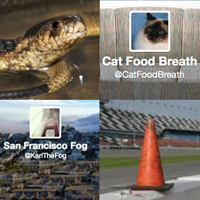In spite of Facebook’s prominence in the social media ecosystem, Twitter is becoming a central source for breaking news. From natural disasters to political campaigning, Twitter delivers real time messaging that have a sense of immediacy. But the characteristics of Twitter also open the doors to a new type of performance art for creative, slightly-bent, would-be comics who create fake Twitter accounts, like @KarltheFog (the San Francisco fog) or @TheOrangeCone (an orange traffic cone who pines for NASCAR).

New media creates new avenues of expression. These entertaining Twitter feeds are a cross between theater and stand-up; the continuity of the feed creates an interactive narrative that weaves the audience into the story. Once again the hurdle for access is lowered. Aspiring comedians used to have to move to New York City or LA, live out of the back of their cars, and perform on street corners until they could talk (or joke) their way into a comedy club. They probably still have to do that, but they can also entertain an audience of thousands on Twitter.
Even those who started a fake Twitter feed as a lark, but have no professional comedic aspirations, are doing a genuine public service. Humor is a powerful and contagious form of communication that spreads positive emotions.
The brilliance of humor–even the 140-character Twitter kind–is that is creates a unique perspective on the world. It takes what we know and shifts it about, giving us a new look at familiar objects, emotions or relationships. Comedy allows to us face to life’s ironies, fears and concerns in a way that is safe, shared and understandable. Laughing minimizes problems and puts them in a healthier perspective.
As Francis Bacon said:
Imagination was given to man to compensate him for what he is not; a sense of humor to console him for what he is.
Humor may console, but laughter (and even smiling) can have longer-term consequences. They have been shown to reduce stress, shift mood and boost the immune system. And you can pass on the benefits by smiling at the next person you meet.
Humor is an advanced cognitive function. It relies on our ability to recognize and understand irony, sarcasm and incongruencies. The human brain loves to solve cognitive puzzles and uncover underlying patterns that are amiss. The pursuit of mystery also makes humor physically rewarding. Surprise and pleasure trigger neural networks that focus our attention and literally feel good through the release of serotonin and endorphins.
New media like Twitter offer easy access to new avenues of expression
You may recall the 2011 snake hunt for an adolescent Egyptian Cobra on the lam from the Bronx Zoo, whose escapades traversing NYC were cleverly chronicled by an anonymous Twitter account @BronxZooCobra. The account gathered tens of thousands of followers in the first 24 hours:
- I want to thank those animals from the movie “Madagascar.” They were a real inspiration.
- Holding very still in the snake exhibit at the Museum of Natural History. This is gonna be hilarious!
- Taking the Sex and the City Tour!!! I’m totally a SSSamantha.
He apparently wasn’t too demoralized by his recapture as he’s still tweeting.
Or perhaps you will be amused by @NatHistWhale, the Twitter account of the Ceiling Whale at the Natural History Museum who provides commentary on the goings on from his (her?) overhead vantage point.
Sometimes the humor becomes a vehicle for real world impact. Twitter’s Romeo the Cat @RomeoTheCat gave a running commentary of the daily life of a two-time rescue cat. His popularity ended up raising $5,000 for animal rescue organizations and garnered the support of a few cat product companies like FURminator, Petco and Iams.
We are used to seeking amusement from videos, films, comics, books or magazines and, in some sense, our use of Twitter is no different. But Twitter is interactive; it allows—often even requires–audience participation for the co-creation of content that can further and expand the story. This creates a sense of ownership and investment in the humor that doesn’t often happen in a traditional ‘comic on the stage’ venue.
Twitter is one of the many tools that invite reimagining story, creative exploration and the extension of content across media channels. Twitter has been used for interesting literary forays, such as Tim Burton’s collaborative story “Stainboy” as well as providing engaging opportunities for fan participation and story world development in transmedia productions. Both authorized actors and unauthorized fans have assumed the characters on popular television shows, like Mad Men, and tweeted in character to provide additional backstory and expand audience interest. Smart media producers recognize the benefit that this type of fan engagement brings, rather than worry about intellectual property infringement. Twitter is especially good for this type of engagement because it creates a sense of immersion and intimacy, the perception of ‘being there’ in the story or world.
Twitter is just one of many new tools that allow creative of narratives. Check out Pinterest for nonlinear storytelling and Storify. Let me know if you have other good resources. In the meantime, I’ll close with @OneTweetTony who only tweeted, as his name suggests, once.

